Science
(www.olympiadsuccess.com)
Chapter 10: Respiration in Organisms
Class VII
Multiple Choice Questions
Question 1
Sometimes when we do heavy exercise, anaerobic respiration takes place in our muscle cells. What is produced during this process?
(a) alcohol and lactic acid
(b) alcohol and CO2
(c) lactic acid and CO2
(d) lactic acid only
Answer 1
(d)
Question 2
Yeast is used in wine and beer industries because it respires
(a) aerobically producing oxygen.
(b) aerobically producing alcohol.
(c) anaerobically producing alcohol.
(d) anaerobically producing CO2.
Answer 2
(c)
Question 3
During the process of exhalation, the ribs move
(a) down and inwards.
(b) up and inwards.
(c) down and outwards.
(d) up and outward.
Answer 3
(a)
Question 4
Breathing is a process that
(i) provides O2 to the body.
(ii) breaks down food to release energy.
(iii) helps the body to get rid of CO2.
(iv) produces water in the cells.
Which of the following gives the correct combination of functions of breathing?
(a) (i) and (ii) (b) (ii) and (iii)
(c) (i) and (iii) (d) (ii) and (iv)
Answer 4
(c)
Question 5
Fish breathe with the help of gills which are richly supplied with blood vessels. The gills help the fish to
(a) take in oxygen from air.
(b) take in oxygen dissolved in water.
(c) absorb nutrients present in water.
(d) release waste substances in water.
Answer 5
(b)
Question 6
Earthworms and frogs breathe through their skin because of which the skin of both the organisms is
(a) moist and rough.
(b) dry and rough.
(c) dry and slimy.
(d) moist and slimy.
Answer 6
(d)
Very Short Answer Questions
Question 7
Mark the following statements as True or False. Correct the false statements.
(a) Oxygen breaks down glucose outside the cells of organisms.
(b) Frogs can breathe through their skin as well as lungs.
(c) Insects have spiracles on the lower surface of the body.
(d) Exhaled air has more percentage of CO2 than inhaled air.
Answer 7
. (a) False : Oxygen breaks down glucose inside the cells of
organisms.
(b) True
(c) False : Insects have spiracles on the sides of the body.
(d) True
Question 8
Fill in the blanks with suitable words.
(a) The roots of a plant take up oxygen from the ______ trapped between the ________ particles.
(b) Diaphragm forms the ___________ of the chest cavity.
(c) Exchange of gases in the leaves take place with the help of __________.
(d) Cockroaches breathe with the help of air tubes called ___________.
Answer 8
. (a) air, soil (b) floor (c) stomata (d) tracheae
Short Answer Questions
Question 9
Pick the odd-one-out from each of the groups given below on the basis of respiratory organs. Give reason for your answer.
(a) cockroach, grasshopper, snail, ant
(b) lizard, cow, earthworm, snake
(c) crocodile, whale, dolphin, fish
(d) snake, tadpole, crow, goat
Answer 9
(a) Snail, as it does not breathe by means of trachea.
(b) Earthworm, because it breathes through its skin and it
does not have lungs.
(c) Fish, as most fish breathe through their gills and do
not have lungs.
(d) Tadpole, as it breathes through gills and does not have
lungs.
Question 10
Which gas present in air is essential for aerobic respiration? What is the role of oxygen during respiration?
Answer 10
Oxygen present in air is responsible for respiration. The oxygen
breaks down food and releases energy.
Question 11
On an average, an adult human being at rest breathes 15–18 times per minute. The breathing rate, however, may differ under different conditions. Arrange the following activities given in the box in order of increasing breathing rates and give reason for your answer.
sleeping, cycling, brisk walk, watching T.V.
Answer 11
sleeping > watching T.V. > brisk walk > cycling
Whenever a person does an activity, the breathing rate
becomes faster. It further increases with strenuous work to
provide more oxygen to the cells to get more energy.
Question 12
On a very cold morning, Boojho and Paheli were talking with each other as they walked down to their school. They observed that the air coming out of their mouth looked like smoke. They were amused and wondered how it happened. Help them find the answer.
Answer 12
On a cold day, the warm and moist air exhaled by us condenses
into mist when it comes in contact with the cold air of the
atmosphere. This looks like white smoke.
Question 13
Whenever we feel drowsy or sleepy, we start yawning. Does yawning help us in anyway?
Answer 13
During drowsiness, our breathing rate slows down. The lungs
do not get enough oxygen from the air resulting in yawning.
Yawning brings extra oxygen into the lungs and helps us to
keep awake.
Question 14
Insects and leaves of a plant have pores through which they exchange gases with the atmosphere. Can you write two points of differences between these pores with respect to their position, number and extension into the body.
Answer 14
(i) Spiracles are present on the sides of insects’ body while
stomata are present on the lower surface of leaves.
(ii) Spiracles are fewer in number as compared to stomata.
(iii) Spiracles lead to an extensive network of tracheal system
which is absent in the leaves.
(you can add more .............)
Long Answer Questions
Question 15
Paheli participated in a 400 m race competition held at her school and won the race. When she came home she had mixed feelings of joy and pain as she had cramps in her leg muscles. After a massage she was relieved of the pain. Answer the following questions related to the situation.
(a) What can be the possible reasons for the pain in her legs?
(b) Why did she feel comfortable after a massage?
Answer 15
(a) The pain in her legs could be because of the
accumulation of lactic acid in the muscles. During heavy
exercise or running, etc., the muscle cells respire
anaerobically and produce lactic acid.
(b) The massage gave her relief because it improves the
circulation of blood leading to increased supply of oxygen
to the muscle cells which helps in complete breakdown
of lactic acid into CO2
and water.
Question 16
Observe Figure 10.1 carefully and answer the following questions.
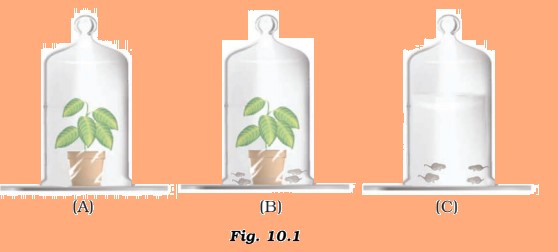
(a) In which jar, will the amount of CO2 be the highest and why?
(b) In which jar, will the amount of CO2 be the lowest and why?
Answer 16
(a) ‘C’. The mice kept under the jar will breathe out CO2
continuously increasing its amount in the bell jar.
(b) ‘A’ jar in which the CO2
released during respiration is
used by the plants during photosynthesis.
Question 17
Observe Figure 10.2 carefully and answer the following questions.
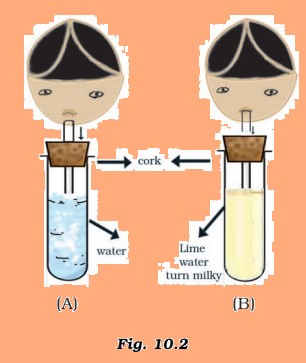
(a) Which process is being tested in the activity?
(b) What is the result of the activity? Give reasons.
Answer 17
(a) Exhalation process during respiration.
(b) The lime water in test tube ‘B’ turns milky but water in
tube ‘A’ remains unchanged. Because CO2
is present in
the exhaled air, it mixes with lime water in ‘B’ and turns
it milky.
Question 18
A food stall owner was preparing dough for making bhaturas. He added a pinch of yeast and sugar to the dough and left it in a warm place. After few hours, the dough had risen. There was a sour smell too.
(a) Why did the dough rise?
(b) Why did the dough smell sour?
(c) Why was sugar added to the dough?
(d) What would have happened if the dough was kept in the refrigerator, soon after it was prepared?
Answer 18
(a) The CO2
released during respiration by the yeast results
in the rise of dough.
(b) During anaerobic respiration, yeast produces alcohol
resulting in sour smell.
(c) Sugar acts as food for yeast.
(d) At low temperatures, yeasts will not multiply and respire
because of which the dough will not rise or become sour.
Question 19
Observe the figures given as Figure 10.3 (A) and (B) and answer the following.
(a) Which of the figures A or B indicates the process of inhalation and which the process of exhalation?
(b) In the figure label the arrows and indicate the direction of
(i) movement of air
(ii) movement of diaphragm
(iii) movement of ribs
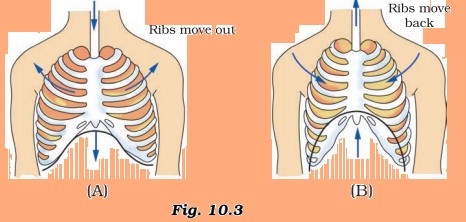
Answer 19
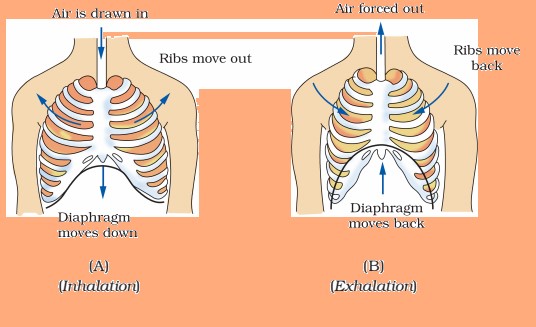
(a) Fig. (A) indicates inhalation, and Fig. (B) indicates
exhalation.
Question 20
Match the names of organisms in Column I with their organs of breathing given in Column II.
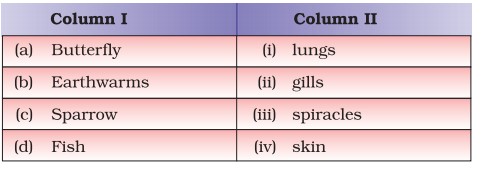
Answer 20
(a) iii; (b) iv; (c) i; (d) ii
Yearlong program for Olympiads preparation & to build necessary skills for future.
Explore More
Time to mark your calendar with the upcoming Olympiads exam schedule.
Explore More
Take your Olympiad preparation to next-level by taking LIVE Classes.
Explore More
Assess your performance by taking topic-wise and full length mock tests.
Explore More
Online tuitions for international compeitions like SASMO, SEAMO, etc for Grades 1-11.
Explore More